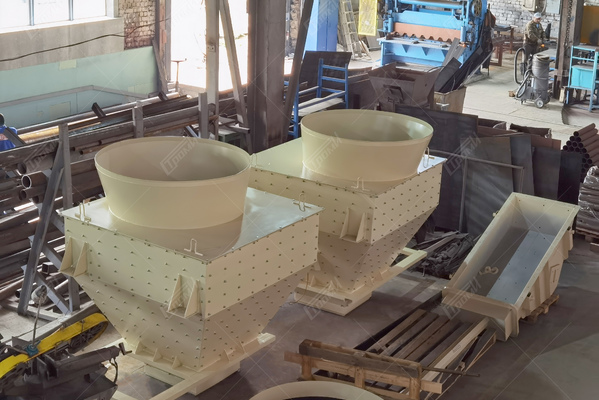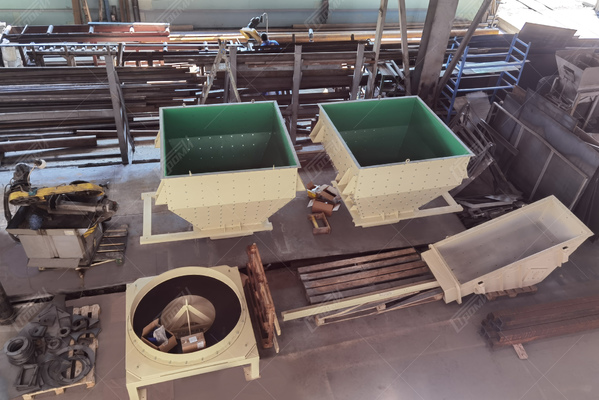Furnace batch hoppers
Design and application
The final stage in the glass charge preparation process within any composite shop involves unloading the charge from mixers into suitable hopper devices. These hopper devices typically comprise intermediate receiving hoppers, transition funnels of various designs, stationary or rotary unloading feeders, vibrating charge flow inducers, aspiration nozzles, and other technological devices. The shape, volume, and number of intermediate receiving hoppers and hoppers largely depend on the chosen mixer type, the unloading mechanisms employed, and the subsequent methods of transporting the raw material mixture to the glass furnaces.
Intermediate receiving hoppers commonly come in rectangular (such as pyramidal, trapezoidal, and combined forms, which combine prism and pyramid elements) or circular (including conical, biconical, and cylindroconical shapes formed by connecting cylinders with circular or elliptical cones). Pyramidal and conical hoppers are utilized when discharging from mixers with a capacity of 500-1500 kg of glass mixture. For dosing and mixing lines (DCL) utilizing mixers with capacities of 1500-5000 liters, trapezoidal, rectangular combined, and cylindrical-conical receiving hoppers with increased internal volumes are preferred.
Rectangular hopper offer a useful volume that exceeds that of similar round containers by 20% at the same height dimensions. The flat surfaces of rectangular hoppers facilitate easier lining with various sheet materials (such as wear-resistant plates, rubber, high-molecular polyethylene, polyurethane, etc.) on the inside. This not only enhances the durability of the hopper devices but also eliminates the formation of corrosion resulting from contact with moistened charge. Furthermore, these linings prevent material hang-up and sticking on the inner walls of the hoppers.
Circular receiving tanks and funnels offer technological advancements and are less prone to the formation of vaults during the unloading of the glass charge. These designs provide improved efficiency and reliability in the unloading process.
The intermediate receiving hoppers of mixers, which can range from one to three depending on the number of discharge units of the mixer, are equipped with various unloading devices. These include stationary and rotary vibrating feeders with suspended and supported structures, reversible and non-reversible conveyors, screw conveyors, and belt feeders. The selection of the unloading device depends on the rational scheme chosen for unloading, intermediate storage, and transportation of the glass charge, as well as any existing construction constraints.
Regardless of their volume, it is common for the receiving hoppers of mixers to have additional requirements. These include the presence of aspiration nozzles in the bunker design, which connect the inner space of the hoppers with the inner space of the mixers. Additionally, strain gauges are used for continuous monitoring of the filling level of these intermediate containers with the charge. By continuously controlling this level (indirectly through the total weight of the bunker), it is possible to prevent the second portion of the mixture from entering the receiving bin, which is intended for a single batch, and to avoid accidental compaction of the charge within it. If necessary, the design of the charge hoppers can be equipped with sealing mechanisms for the discharge opening, which may include a sector shutter or a disc rotary flap.
When designing and manufacturing hopper devices for charge mixers, Stromizmeritel carefully selects optimal designs based on the performance and type of mixing devices, as well as the specific design requirements for loading, unloading, intermediate storage, and transportation of the glass charge. This ensures that the overall process operates smoothly and efficiently, meeting the specific needs of the glass production industry.


